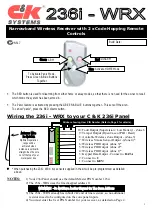
Operating Controls and Features
1. Channel selector
2.Channel indicator
3.S/RF indicator
4.Band Selector
5.Off/Volume Control
6.RX indicator
7.Squelch Control
8.TX indicator
9.RF Gain Control
10. AM indicator
11. FM indicator
A 40-detent rotary, switch to select any of 240 channels in conjunction with the
Band Selector switch.
Window above this switch indicates the channel selected using an LED (Light-emitti-
ng-diode)digital readout.
A digital LED display to show channel selected.
Turned off when operating PA.
When an incoming signal is received the RX indicator will illuminate. and the signal
indicator will illuminate to monitor the relative strength of the signal. The strength
of the incoming signal will depend on the performance of the transmitter and aerial,
your distance from it and the nature of the surrounding area, not on your set s
ability to receive the transmitted signal.
Power output is registered by the LED indicators.
Selects a group of 40 channels in six positions - A, B, C, D, E or F (240 in all).
Varies the sound output form the speaker. Also incorporates an on-off switch at the
extremely counterclockwise position.
Lights up when receiving.
Used to eliminate any annoying background noise when no signals are present. The
degree of sensitivity to incoming signals is adjustable. When the Squelch control
is rotated to the fully clockwise position, it provides maximum squelch, in the fully
counterclockwise position, it provides minimum squelch.
Lights up when transmitting.
Selects RF Gain (receiver sensitivity) of the transceiver in variations.
MAX. In this position, the receiver section provides maximum sensitivity so that it
can pick up even weak signals.
Normally this switch should be placed in this position.
MIN. In this position, the receiver sensitivity is minimum, and the receiver will pick
up only the strong signals. May be used when receiving strong (close) signals which
are causing overload in receiving sound.
Lights up when operating AM
Lights up when operating FM
5
’






























